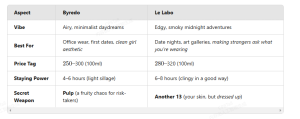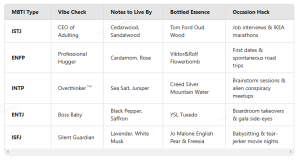Ever sniffed a perfume and been instantly teleported to your grandma’s kitchen, *literally* tasting her infamous cinnamon rolls? Or caught a whiff of cedarwood and suddenly you’re 12 again, swatting mosquitoes by a campfire? That’s the magic of fragrance—it’s a time machine, mood ring, and heartstring-tugger, all in one bottle. Forget generic gift cards; picking the *right* scent shows you’ve paid attention to their secret obsessions, hidden quirks, and core memories. Ready to become a fragrance matchmaker who’s part Cupid, part Sherlock Holmes? Let’s brew this potion.
Why Perfume = The Ultimate “I Get You” Gift
Scents have a VIP pass to our brains. Science says smell is the only sense directly wired to the limbic system (aka the nostalgia HQ). One spritz can spark joy, summon a crush flashback, or even reignite wanderlust—like bottling a Parisian café or a Hawaiian sunset. Plus, perfume is the gift that *keeps* giving—every time they wear it, they’ll think of you (no pressure, right?).
Pro Tip: Not sure where to start? Mini discovery sets (like Sephora’s sampler kits or Scentbird’s monthly drops) let them test-drive scents guilt-free. Bonus: Sneak a peek at their leftovers to sleuth their faves!
Fragrance Matchmaking 101: Pair Scents Like a Pro
For Your Sweetheart
– New Flames (0-6 months): Keep it flirty, not overwhelming. Think *sun-kissed citrus* (bergamot, yuzu) or *barefoot-in-a-field florals* (peony, honeysuckle). *Molecule 01* is a cult fave—it morphs with their skin chemistry like a chameleon in love. Magic!
*Avoid:* Heavy musks or overly spicy notes—save the intensity for anniversary gifts.
– Ride-or-Die Partners: Go cozy-sexy. *Vanilla* (not cupcake, more “smoldering fireplace”) or *sandalwood* whispers “Netflix & Chill” in the classiest way. Try *Le Labo Santal 33*—it’s like a leather jacket in liquid form. *Commodity Milk* adds a dash of marshmallow warmth for cuddle-core vibes.
Family Ties
– Parents/Grandparents: Stick to classics with a twist. *Lavender* with a hint of *tonka bean* (Jo Malone’s *Lavender & Tonka*) or *rosemary-infused colognes* (Aesop’s *Rōzu*). Nostalgia, but make it chic.
*Pro Tip:* Vintage-loving folks? Hunt down limited re-releases like *Chanel No. 5 L’Eau*—retro, but rebooted.
– Siblings: Inside jokes in scent form! Bonded over beach trips? *Sea salt + coconut* (Tom Ford’s *Soleil Blanc*). Still quoting *Mean Girls*? *Cotton candy + glitter* (Ariana Grande’s *Cloud*). For the sibling who’s a midnight snacker, *Byredo’s *Sundazed* smells like lemonade and sunshine—no crumbs required.
Friendships
– BFFs: Match their vibe. Boho queen? *Patchouli + rose* (Byredo’s *Gypsy Water*). Gym rat? *Fresh-cut grass + rain* (Maison Margiela’s *When the Rain Stops*). Wine mom? *Grapefruit + champagne* (Kayali’s *Citrus 08*).
– Work Wives/Husbands: Subtle but sophisticated. *White tea* (Elizabeth Arden’s classic) or *fig + musk* (Diptyque’s *Philosykos*)—nothing that’ll gaslight the conference room. *Glossier You* is a safe bet—it’s like a clean sweater hug.
For the Wanderluster
Got a friend who’s always jet-setting? Bottle their travel dreams: *Maison Margiela’s Replica* line nails locales—*By the Fireplace* for cabin escapes, *Beach Walk* for tropical vibes.
Avoid Disaster: 5 Fragrance Faux Pas (Yes, We Added More)
- Don’t blind-buy polarizing notes (oud, cumin, or anything labeled “animalic”). Unless you *want* them to smell like a medieval apothecary.
- Skip the giant bottle. Cute travel sprays > commitment-phobe sizes. *Bonus:* They’re TSA-friendly!
- Never gift “body spray” to anyone over 16. Axe-adjacent vibes = instant side-eye.
- Avoid overly trendy scents (looking at you, celery-infused perfumes). Stick to timeless with a twist.
- Don’t ignore the season. Heavy orientals in summer? *Sweaty.* Light florals in winter? *Basic.*
Budget Hacks for Scent Savants
– Dupes FTW: Zara’s *Fields at Nightfall* is a $30 dupe for YSL’s $300 *Black Opium*. Oakcha’s *Sweven* clones *Baccarat Rouge 540* for a fraction.
– DIY Layering: Pair a basic vanilla lotion with a luxe perfume oil (try Nest’s *Madagascar Vanilla*). Genius *and* personal.
– Sample Swaps: Join Reddit’s r/fragranceswap or local FB groups to trade decants. Free sniffies!
The Receipt Rule (& Other Jedi Mind Tricks)
– Always include a gift receipt. Fragrance is *super* personal—no one wants to ugly-cry over guilt.
– Stalk their IG saves. Do they hashtag #VanillaGirl or #CitrusVibes? Pinterest boards? Sleuthing = success.
– Casually ask: “What’s your favorite candle scent?” or “What smell reminds you of childhood?” *Boom*—intel acquired.
Final Spritz
Gifting perfume isn’t just about smelling good—it’s about bottling a feeling. Whether it’s the zing of a new romance or the warmth of decades-old love, the right scent says what words can’t. And hey, if you bomb? At least it’s a funny story. (My boss still side-eyes me for gifting him *Byredo’s Burning Rose*—aka “smoky campfire core.”)
P.S. My first perfume gift? A $20 bottle of *Britney Spears’ Curious* for my BFF in 2007. She still wears it… and we’re still stealing each other’s fries.

